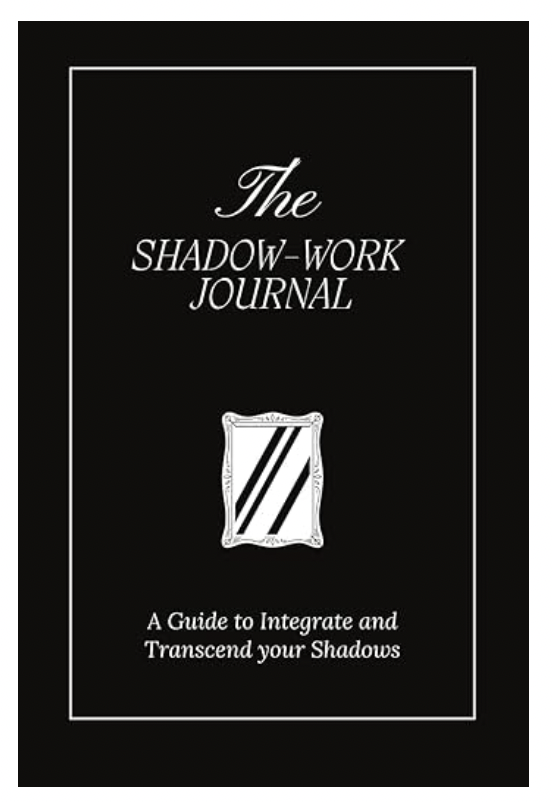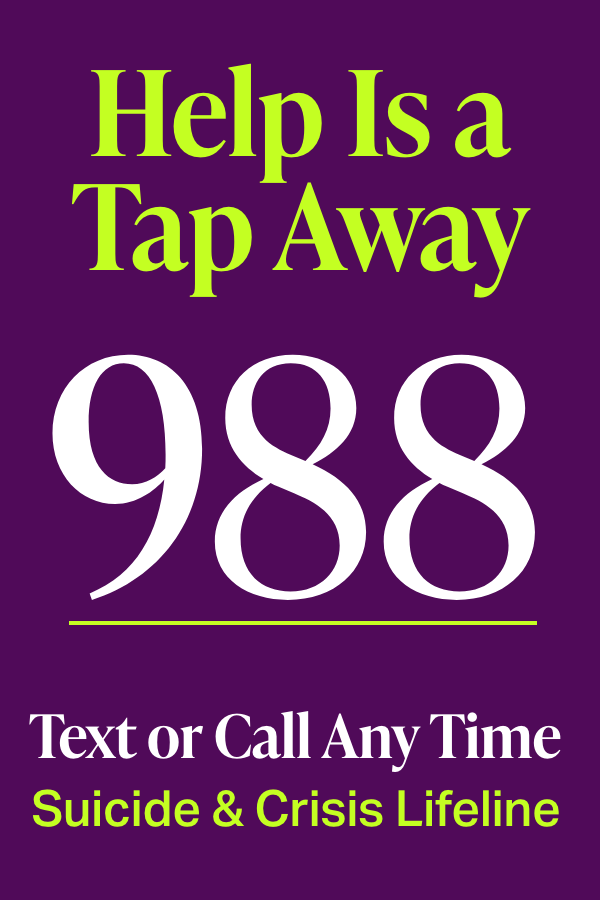Brionna (whose TikTok username is @wunderbri) stares down her Shadow Work Journal and takes a heaving sigh as she reads the first prompt.
“I decided to film myself doing the first exercise. Then I read back what I wrote,” the white text across her video reads. She clicks her pen nervously and after a few seconds, her eyes well up with tears, and her bottom lip starts to quiver. “Oh fuck me,” she says, cutting the recording off. Her caption: “This is going to be tough. #shadowwork #mentalhealth #therapy.”
If you’re on TikTok, there’s a good chance that similar videos have come across your FYP—in droves. Posts tagged #shadowwork have generated more than 2.1 billion views. There are videos of people looking down at their journal and crying like Brionna did, people talking about how the journal has helped them heal their inner child, videos of people sharing their favorite prompts, and everything in between.

The vast, vast majority of these videos are not posted by people with any professional mental health training—even the videos on how to prepare yourself before you cozy up with your Shadow Work Journal. This is social media, after all, the wild west of mental health advice. For those who stumble across the videos, it’s natural to wonder if it’s legit helpful or if it’s, well, shady.
What Is Shadow Work and The Shadow Work Journal?
Shadow work may be all over social media now, but it’s nothing new. It actually dates back to the late 1800s.
Shadow work was popularized by famed psychiatrist Carl Jung, explains psychologist Nathan Brandon, Psy.D., who trained at the C.G. Jung Institute of San Francisco. Dr. Jung was all about uncovering the unconscious mind, which is essentially what shadow work purports to do.
“Shadow work is a psychological self-exploration process that encourages individuals to examine and integrate the unconscious aspects of their personality, often referred to as their ‘shadow,’” Dr. Brandon says.
GOTTA READ: Best Journals for Your Mental Health
Dr. Jung believed that everyone has a part of themself that’s hidden from their conscious awareness. “The shadow refers to the parts of us that have become hidden, rejected, or repressed,” says psychologist Janine O’Brien, Psy.D., who often incorporates shadow work into her therapy sessions with clients. “These parts of us have become repressed through experiences, messaging, or socialization that we have received along the way,”
Example: “Say you were told early in your life that you were too loud,” Dr. O’Brien says. “Because of this, you were sent the message that being loud is ‘bad’ and therefore a part of you that should not be shown.”
Sign up for our free newsletter
Legit tips and cool copes, delivered straight to your inbox.
By completing this form you are signing up to receive our emails and can unsubscribe anytime.
“One of the insights Dr. Jung had was that we can bury absolutely anything that we’re shamed, punished, or criticized for as kids,” explains therapist Connie Zweig, Ph.D., a shadow work expert who has written several books on the subject. When we’re young, we try to get approval from our parents, teachers, and other adults. We get messages from them about what’s acceptable and what isn’t. Anything about ourselves deemed unacceptable can get repressed, she says.
But here’s the thing: The parts we’re repressing (i.e., being “too loud”) still exist. “When shadow parts remain repressed, it’s likely that you will notice yourself experiencing emotional triggers, repeating dysfunctional or unhelpful patterns, and possibly experiencing a general sense of dissatisfaction,” Dr. O’Brien says. For example, one scientific study found that people distance themselves from individuals who show characteristics they fear, or suppress, in themselves.
Enter: shadow work. “Shadow work helps to bring the shadow into the ‘light.’ This awareness and consciousness gives you an opportunity to change destructive or unhelpful patterns,” says Dr. O’Brien. (In other words, you face your shadows.) And then, she says, you “move into a place of more acceptance.”
That’s the theory anyway. Dr. O’Brien admits there’s not much scientific research or evidence on the effectiveness of shadow work. But anecdotally, many people have found it to be beneficial.
So why is everyone suddenly interested in shadow work? Dr. Brandon thinks it’s because more people are seeking self-awareness and emotional wellness. (Prioritizing your mental health: so hot right now.)
It also likely has to do with The Shadow Work Journal, which was written by Keila Shaheen, a certified cognitive behavioral therapy practitioner who also worked at TikTok as a brand strategist from 2021 to 2022. Shaheen did take a course on CBT and does have a bachelor’s degree in psychology. However, she is not a licensed therapist. Her shadow work journal includes exercise where you fill in the blanks. Here’s an example:
“As a child, I was yelled at for ___________. My response to this was _________ and _________. After this, I’ve always been __________. I care so much about ____________. It triggers me now when ______________. Now I hold a compassionate space for my full self and embrace this part of me.”
The idea is that through journal prompts like this one, you eventually get to the root of your shadow. You start uncovering parts of yourself that you’ve repressed. These parts may be impacting areas of your life without you even realizing it, such as through certain harmful behaviors or unhealthy relationship dynamics.
Think You’re Ready to Give Shadow Work a Shot?
Not all therapists are super-stoked about the shadow work trend. Imi Lo, a therapist trained in Dr. Jung’s theories, says she’s happy TikTok is raising awareness about shadow work. But, at the same time, she has major concerns about people relying on social media instead of working with a therapist who’s trained in it.
“When something gains popularity online, it’s susceptible to misinterpretation and distortion,” says Lo, who now works primarily as a mental health consultant and author. “This leads to misconceptions that can encourage people to experiment with techniques that may not be genuinely helpful.”
With this in mind, if you come across people giving you advice about shadow work on social media (such as how to do it or what you can learn from it), make sure they’re actually qualified to be talking about it. No matter how thought-provoking their words are, don’t just assume what they’re saying is fact.
If you do decide to try it, ask yourself the following three questions before you get started. If you can’t answer hell yes to each, it’s a no.
1. Are you in a good place mentally?
Before you decide to dive into The Shadow Work Journal—or any journal related to shadow work, for that matter—Dr. O’Brien says to think about why you’re doing it and where you are mentally. If you’re not currently in a good emotional space, have past trauma you haven’t yet worked through, or have an inkling that shadow work would lead to uncovering past trauma, it’s best to work with a trained mental health professional.
A therapist can help you determine if shadow work is right for you, Dr. O’Brien says, and tailor the experience to support your individual healing journey.
“Shadow work can then be used to help you uncover the origins of triggers, unhelpful patterns, and ultimately the roots of trauma. When this is uncovered in a safe space and you have more understanding, it provides the opportunity to confront the trauma from a compassionate lens,” she says.
Dr. Zweig says some people have the resilience to recover from trauma without therapy. But for others, not working with a therapist can lead to further emotional and mental harm. Lo agrees, saying that someone should consider if and when they feel ready to move past trauma. Then, seek therapy (if they believe it will be helpful to them) when they are ready.
2. Do you feel safe?
Consider yourself emotionally stable and want to use shadow work to learn more about yourself? The experts say that using a shadow work journal can be beneficial. Before you start, it’s helpful to center yourself through meditation or, if you’re spiritual, even prayer, says Dr. Zweig.
“Shadow work can be challenging, but a centering practice gives you something [safe] to come back to,” she says. If any difficult emotions start to come up, remember that you can always come back to your meditation or prayer practice. Both can help you feel more grounded.
3. Are you ready to face the unknown?
In other words: Are you ready for what you may uncover? “Remember, this is a deeply personal journey toward self-discovery, and it’s okay to feel overwhelmed at times,” Dr. Brandon says. “Be patient with yourself and allow the process to unfold at its own pace.”
Sometimes, you really don’t know you’ve experienced trauma until a shadow work journal prompt brings it to light. When this happens, it can be difficult to deal with alone. This is another time when you want to loop in your therapist—or start seeing one if you don’t have one already.
If you really want to get the most out of shadow work, it’s important to be consistent. “Make it a daily habit to spend some time with your journal,” says Dr. Brandon. “This consistency helps you develop a deeper connection with your subconscious mind.”
What You Can Expect from Shadow Work
Okay, you’re centered and emotionally prepared to deal with whatever the journal prompts bring up for you. Self-actualization, here you come!
But what’s going through a shadow work journal actually like? This varies hugely from person to person, because shadow work is a very individual experience, Dr. Zweig says. Despite what you might have heard on TikTok, it isn’t all uncomfortable or heavy.
Sometimes, people uncover a really cool part of themself that has been buried, Dr. Zweig notes. For example, someone may learn that they’re actually pretty creative, something they might not have known because, throughout childhood, adults sent the message that it was important to be academic and creative pursuits were frivolous.
But yes, other times, working through the journal can be uncomfortable. “As individuals delve into their unconscious mind, they may encounter feelings of discomfort, fear, and sadness as they confront their suppressed emotions and past traumas,” Dr. Brandon says.
But he emphasizes that these feelings are often temporary and then give way to feelings of relief and liberation as you begin to understand yourself more. “Ultimately, shadow work is a transformative process that fosters personal growth and emotional resilience,” he says.
Over time, shadow work can help you live life more authentically instead of the way you think you’re “supposed” to act, Lo says.
“You can expect to gain a whole bunch of insights and personal growth about what lies beneath your mask,” she says. “You’ll uncover those hidden emotions, behaviors, and thoughts that you’ve been brushing under the rug. It’s like turning on the lights in the dark corners of your mind.”
As you might expect, all this personal growth stuff can impact your relationships, too. “When you confront your own shadows, you’ll find that you’re less likely to project them onto others. That means fewer misunderstandings and conflicts,” Lo says.
All four experts say that shadow work can also be integrated into therapy. And if you are uncovering any past trauma, you absolutely should embrace it. You can discuss certain journal prompts or something that you discovered about yourself with your therapist, who can help you dig deeper into what it means while creating a safe space for you to do so.
That said, shadow work does not have to be part of trauma therapy. Many therapists use other methods without incorporating it. This includes trauma-focused cognitive behavioral therapy, cognitive processing therapy, or eye movement desensitization therapy, which have all been scientifically linked to helping with trauma on their own.
Bottom line: Shadow work can help you uncover parts of yourself you have unconsciously been keeping hidden. This can lead to some spectacular self-growth. But if you have past trauma that you haven’t confronted or healed from, please, pretty please, work with a therapist and don’t rely on a shadow work journal (or any type of journal for that matter) to process and move past it.
Turning the lights on can bring clarity, but it can also illuminate a whole lot of mess you didn’t know was there. If that’s the case for you, shadow work may just be the beginning. And that alone makes it worth trying.
READ NEXT: Should You Actually Bring Your Whole Self to Work?
Shadow Work and Carl Jung: The Jungian Shadow. Society of Analytical Psychology.
Dr. Jung and the Unconscious Mind: Collective unconscious. Britannica.
Hiding Things We’re Shamed For: Mayer CH. Shame—”A Soul Feeding Emotion”: Archetypal Work and the Transformation of the Shadow of Shame in Group Development Process. The Value of Shame. April 2017.
Traits We Fear in Ourselves: Schimel J, Psyszczynski T, Greenburg T, et al. Running from the shadow: psychological distancing from others to deny characteristics people fear in themselves. Journal of Personality and Social Psychology. March 2000.
Shadow Work Evidence: Roesler C. Evidence for the Effectiveness of Jungian Psychotherapy: A Review of Empirical Studies. Behavioral Sciences. December 2013.
Trauma-Focused Cognitive Behavioral Therapy: Ramirez de Arellano MA, Lyman DR, Jobe-Shields L, et al. Trauma-Focused Cognitive Behavioral Therapy: Accessing the Evidence. Psychiatric Services. May 2015.
Cognitive Processing Therapy: Tran K, Moulton K, Santesso N, et al. Cognitive Processing Therapy for Post-Traumatic Stress Disorder: A Systematic Review and Meta-Analysis. CADTH Health Technology Assessment. March 2016.
Eye-Movement Desensitization and Reprocessing: Grainer D, Alam S, Alam H, et al. A Flash of Hope: Eye-Movement Desensitization and Reprocessing (EMDR) Therapy. Innovations in Clinical Neuroscience. July – September 2020.






